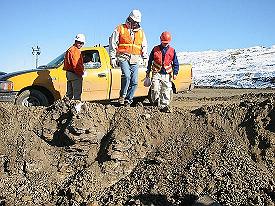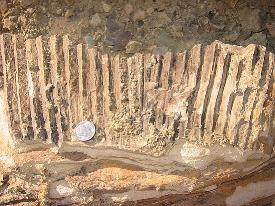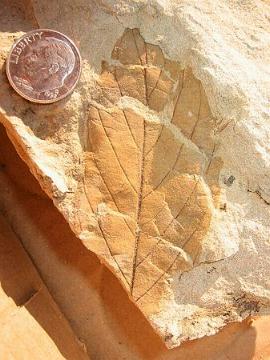



 |
The "Fossil
Posse" (see note 1) was dispatched
to the Northwest Parkway construction project near Brighton, Colorado.
Construction workers had unearthed a portion of the Laramie Formation dated
at 69-68 million years old.
It has been a very long time since a Cretaceous fossil plant locality has been discovered in this area. So, on 11/26/2002, we didn't let sub-freezing temperatures or snow on the ground dissuade us. Current efforts at the Northwest Parkway construction project involve removing massive amounts of earth for the new highway. Fortunately, most of this work is done at night so the trucks do not interfere with daytime traffic. This allowed us to do our work with no impact to the construction efforts which is a high priority to both the Fossil Posse and the construction project. One of the construction workers was excited about his discovery and arrived at the site just as we were unpacking our equipment. He walked right over to the hillside and immediately began handing us Cretaceous palm leaves. We have great admiration for construction projects and crews that understand that the fossils they are finding may be important to science. We thank them for reporting their discovery and, in return, we try to have little or no impact on the project schedules. During our 3 1/2 hour recovery effort on 11/26/2002, we filled about 13 cardboard flats with beautiful fossil plants. On 12/14/2002 we took home a similar amount of fossils in a 4 1/2 hour effort. I've yet to identify all of our findings, but have placed them on Paleocurrents.com until we do more research. The leaf-producing sedimentary layers of this Laramie locality were primarily a dull yellow, fine-grained sandstone. The layers above the leaf producing section were a whitish sandstone with highly chaotic deposition which preserved fossil wood and many burrows, but few fossil leaves. We found a small tree trunks in situ (in upright growth position) in this white sandstone layer. The section above the white sandstone contained beautiful alternating layers of sandstones and mudstones. (See image gallery links below) The excavation site was in the side
of a very unstable earthen hill. At times, large portions of the
hillside would collapse either on its own or from the sounds of our hammering.
We thank Mark Panuska for his guidance with safety issues. "Safety
is Job #1", right?
11/26/2002 Excavation Team:
|
1. The
"Fossil Posse" is a group of staff and volunteers at the Denver
Museum of Nature & Science (DMNS) specifically organized to respond
rapidly to fossil discoveries. For more on the Fossil Posse, CLICK
HERE.
Hosting donated by Wagner Database Solutions, Inc. |